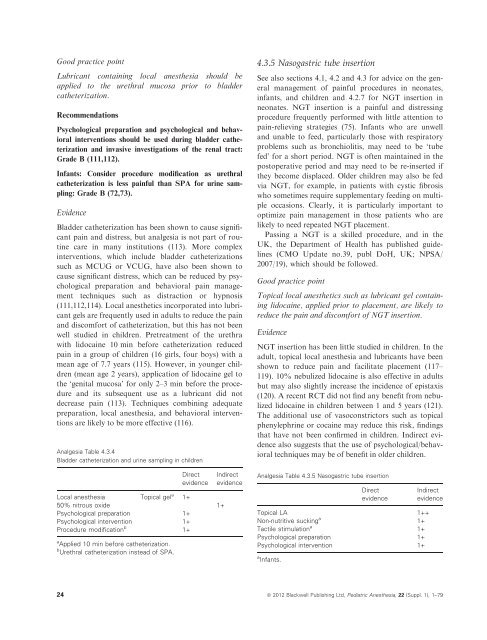Good Practice in Postoperative and Procedural Pain Management ...
Good Practice in Postoperative and Procedural Pain Management ...
Good Practice in Postoperative and Procedural Pain Management ...
Create successful ePaper yourself
Turn your PDF publications into a flip-book with our unique Google optimized e-Paper software.
<strong>Good</strong> practice po<strong>in</strong>tLubricant conta<strong>in</strong><strong>in</strong>g local anesthesia should beapplied to the urethral mucosa prior to bladdercatheterization.RecommendationsPsychological preparation <strong>and</strong> psychological <strong>and</strong> behavioral<strong>in</strong>terventions should be used dur<strong>in</strong>g bladder catheterization<strong>and</strong> <strong>in</strong>vasive <strong>in</strong>vestigations of the renal tract:Grade B (111,112).Infants: Consider procedure modification as urethralcatheterization is less pa<strong>in</strong>ful than SPA for ur<strong>in</strong>e sampl<strong>in</strong>g:Grade B (72,73).EvidenceBladder catheterization has been shown to cause significantpa<strong>in</strong> <strong>and</strong> distress, but analgesia is not part of rout<strong>in</strong>ecare <strong>in</strong> many <strong>in</strong>stitutions (113). More complex<strong>in</strong>terventions, which <strong>in</strong>clude bladder catheterizationssuch as MCUG or VCUG, have also been shown tocause significant distress, which can be reduced by psychologicalpreparation <strong>and</strong> behavioral pa<strong>in</strong> managementtechniques such as distraction or hypnosis(111,112,114). Local anesthetics <strong>in</strong>corporated <strong>in</strong>to lubricantgels are frequently used <strong>in</strong> adults to reduce the pa<strong>in</strong><strong>and</strong> discomfort of catheterization, but this has not beenwell studied <strong>in</strong> children. Pretreatment of the urethrawith lidoca<strong>in</strong>e 10 m<strong>in</strong> before catheterization reducedpa<strong>in</strong> <strong>in</strong> a group of children (16 girls, four boys) with amean age of 7.7 years (115). However, <strong>in</strong> younger children(mean age 2 years), application of lidoca<strong>in</strong>e gel tothe ‘genital mucosa’ for only 2–3 m<strong>in</strong> before the procedure<strong>and</strong> its subsequent use as a lubricant did notdecrease pa<strong>in</strong> (113). Techniques comb<strong>in</strong><strong>in</strong>g adequatepreparation, local anesthesia, <strong>and</strong> behavioral <strong>in</strong>terventionsare likely to be more effective (116).Analgesia Table 4.3.4Bladder catheterization <strong>and</strong> ur<strong>in</strong>e sampl<strong>in</strong>g <strong>in</strong> childrenDirectevidenceLocal anesthesia Topical gel a 1+50% nitrous oxide 1+Psychological preparation 1+Psychological <strong>in</strong>tervention 1+Procedure modification b 1+a Applied 10 m<strong>in</strong> before catheterization.b Urethral catheterization <strong>in</strong>stead of SPA.Indirectevidence4.3.5 Nasogastric tube <strong>in</strong>sertionSee also sections 4.1, 4.2 <strong>and</strong> 4.3 for advice on the generalmanagement of pa<strong>in</strong>ful procedures <strong>in</strong> neonates,<strong>in</strong>fants, <strong>and</strong> children <strong>and</strong> 4.2.7 for NGT <strong>in</strong>sertion <strong>in</strong>neonates. NGT <strong>in</strong>sertion is a pa<strong>in</strong>ful <strong>and</strong> distress<strong>in</strong>gprocedure frequently performed with little attention topa<strong>in</strong>-reliev<strong>in</strong>g strategies (75). Infants who are unwell<strong>and</strong> unable to feed, particularly those with respiratoryproblems such as bronchiolitis, may need to be ‘tubefed’ for a short period. NGT is often ma<strong>in</strong>ta<strong>in</strong>ed <strong>in</strong> thepostoperative period <strong>and</strong> may need to be re-<strong>in</strong>serted ifthey become displaced. Older children may also be fedvia NGT, for example, <strong>in</strong> patients with cystic fibrosiswho sometimes require supplementary feed<strong>in</strong>g on multipleoccasions. Clearly, it is particularly important tooptimize pa<strong>in</strong> management <strong>in</strong> those patients who arelikely to need repeated NGT placement.Pass<strong>in</strong>g a NGT is a skilled procedure, <strong>and</strong> <strong>in</strong> theUK, the Department of Health has published guidel<strong>in</strong>es(CMO Update no.39, publ DoH, UK; NPSA/2007/19), which should be followed.<strong>Good</strong> practice po<strong>in</strong>tTopical local anesthetics such as lubricant gel conta<strong>in</strong><strong>in</strong>glidoca<strong>in</strong>e, applied prior to placement, are likely toreduce the pa<strong>in</strong> <strong>and</strong> discomfort of NGT <strong>in</strong>sertion.EvidenceNGT <strong>in</strong>sertion has been little studied <strong>in</strong> children. In theadult, topical local anesthesia <strong>and</strong> lubricants have beenshown to reduce pa<strong>in</strong> <strong>and</strong> facilitate placement (117–119). 10% nebulized lidoca<strong>in</strong>e is also effective <strong>in</strong> adultsbut may also slightly <strong>in</strong>crease the <strong>in</strong>cidence of epistaxis(120). A recent RCT did not f<strong>in</strong>d any benefit from nebulizedlidoca<strong>in</strong>e <strong>in</strong> children between 1 <strong>and</strong> 5 years (121).The additional use of vasoconstrictors such as topicalphenylephr<strong>in</strong>e or coca<strong>in</strong>e may reduce this risk, f<strong>in</strong>d<strong>in</strong>gsthat have not been confirmed <strong>in</strong> children. Indirect evidencealso suggests that the use of psychological/behavioraltechniques may be of benefit <strong>in</strong> older children.Analgesia Table 4.3.5 Nasogastric tube <strong>in</strong>sertionDirectevidenceTopical LA 1++Non-nutritive suck<strong>in</strong>g a 1+Tactile stimulation a 1+Psychological preparation 1+Psychological <strong>in</strong>tervention 1+a Infants.Indirectevidence24 ª 2012 Blackwell Publish<strong>in</strong>g Ltd, Pediatric Anesthesia, 22 (Suppl. 1), 1–79
















